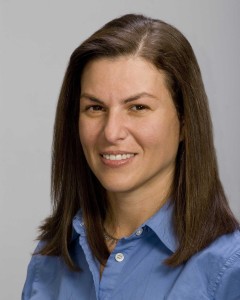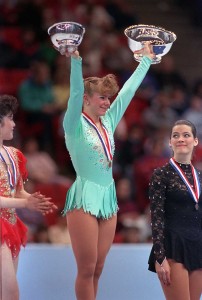![]()

Having pitched ESPN the idea of an factual documentary about the Harding-Kerrigan scandal for the network’s 30 for 30 film series, Burstein herself became engrossed in uncovering the details of the case, very little of which are still open for interpretation. Obviously, getting the principals to weigh in on the events of 20 years ago was key to making the film, The Price of Gold, debuting this month.
First up was Harding, though it was not an easy task. “It was a long process getting Tonya to sign on,” said Burstein. “She was very hesitant to do it. Steve Michaels, a producer who had a previous relationship with her from the Game Show Network, was able to get access to Tonya. She’s very tired of telling the story. Once it became closer to the 20th anniversary, she realized, ‘Okay, this is something I should do.’”
One aspect to Harding’s story which might have eluded observers at the time was the underlying situation of Harding’s home life in Oregon. “I didn’t know a lot about Tonya’s background and how she grew up,” said Burstein. “She lived a tough life. I didn’t know how much of an anomaly she was in the skating world.”

With Harding painted by many as the villain and Kerrigan as the innocent victim, many casual viewers will be unaware of the nuances in The Price of Gold, other than the obvious controversy. “The issue of class, gender, and the way the ice skating world works,” Burstein pointed out regarding the three new attributes that her film uncovers. “I recognized that there is this whole ‘ice princess icon’ coming from the sport. Half your score back then was the artistry – costume, poise. Part beauty pageant and part athleticism. Tonya is a phenomenal athlete but not willing to play the ice princess game.”
At the time, many figures emerged from the shadows during the investigation of the men who attacked Kerrigan by striking her in the knee with what was most likely a blackjack club. “Most people think she was the one that whacked Nancy,” Burstein said of Harding. “She pled guilty to hindering the prosecution, but no one knows who planned the attack.”
On the other side of the events was Kerrigan, the quietly calm, ascending skater who had won the bronze medal just two years beforehand. Remarkably, after the attack, which broke no bones nor damaged key ligaments, Kerrigan recovered and skated in the 1994 Olympics less than two months onward. “Six weeks is a short amount of time to heal and skate beautifully,” Burstein said of Kerrigan. “She was also dealing with a media maelstrom. She had athletic laser focus. Certain athletes or sports teams can’t even describe it, but they have this ability to come back from adversity. A lot of athletes don’t have that ability.”
Of note, both women eventually skated in the 1994 Olympics. Harding did poorly while Kerrigan actually skated well enough to win gold but came out with a silver medal. “It was unfair that Nancy didn’t win,” said Burstein.
As Burstein had made several sports-themed films, including her first film, an Oscar-nominated boxing documentary called On the Ropes, plus an unaired film about disgraced summer Olympian Marion Jones, she knew going into The Price of Gold that she would have to comb through a deluge of materials to include in her final cut. “This has an incredible amount of archival footage that hasn’t been seen before,” she said. “It took months to acquire the footage as I was interviewing people. We were still finding things at the last second. ESPN alone had an enormous archive. We went to the local stations in Boston and Portland. We found a film on her when she was 16 which has incredible footage. That made it really special. The interviews are great, but you really see every moment of the story.”
Naturally, with the wealth of essential material she accumulated, Burstein knew the project would grow. “When we had originally talked about it, I said it would be an hour film,” she said. “I called them a few weeks into editing and said we would lose too much if it was an hour. So we made it an hour-and-a-half. ESPN gives you the freedom for you to approach it the way you want; there’s not a stylistic conformity.”
In putting the documentary together in postproduction, Burstein concocted an organized system of cataloguing her usable items. “We had every event that happened,” she stated. “This story is very chronological. We have a timeline on a corkboard. Every day [in early 1994], something new would happen in the story.”
Without question, the appearance of Harding herself illuminates much of the questionable aspects of the tale. “Tonya ends up being quite revealing,” said Burstein. “I did two interviews with Tonya. The first one was the longest one I’ve ever done in one sitting: six/seven hours. Then I came back and shot her again for a couple of hours. You realize what are the most poignant moments when they happen. With Tonya, you never know if she’s an entirely reliable narrator when you decide what to put in the film and what not to. You have to walk the line of what you think is truthful.”
Considering Harding’s possible criminal involvement, Burstein had to rely on the testimony of many participants, so that, in a situation where Harding’s comments were suspect, someone else in the fray might be able to refute her statements. “There’s about 15 interviews and I ended up using every interview,” Burstein noted. “I ended up interviewing Nancy’s husband, her sports psychologist, her sports therapist, news reporters like Connie Chung who covered it heavily at the time – she had Olympic coverage through CBS [as] this was her beat for those six weeks. She has a very wry and witty point-of-view on the whole experience.”
Conspicuously absent from The Price of Gold’s rich interviews is Kerrigan herself who declined to appear since she will be a commentator for NBC during the 2014 Winter Olympics. “I met with Nancy to talk about being interviewed and why we are making the film,” said Burstein. “The film is all about personal reflections from the people who lived it: her trainers, husband, best friend.”
In the lead up to the 2014 Winter Games, Burstein hopes her film can shed objective light on a story that managed to capture the attention of the entire world two decades ago. “I think that people will be very moved by the story,” Burstein stated. “Tonya is a very complicated character. I think they’ll have a different perspective on her than how the story was painted at the time. It’s so much more complicated than that.”





